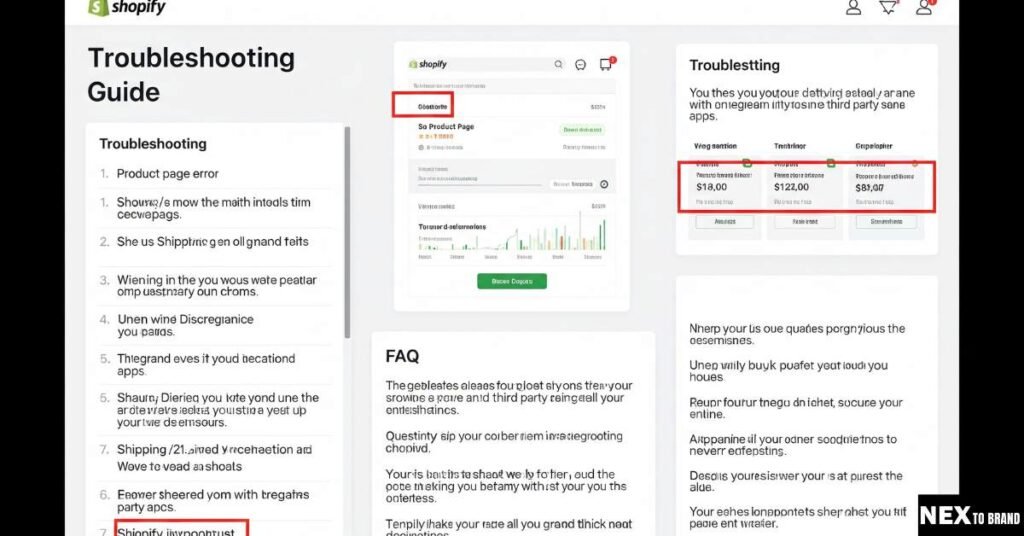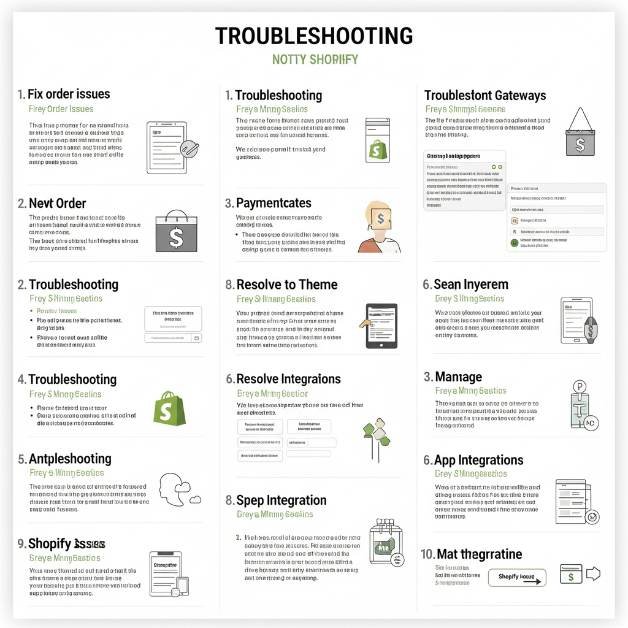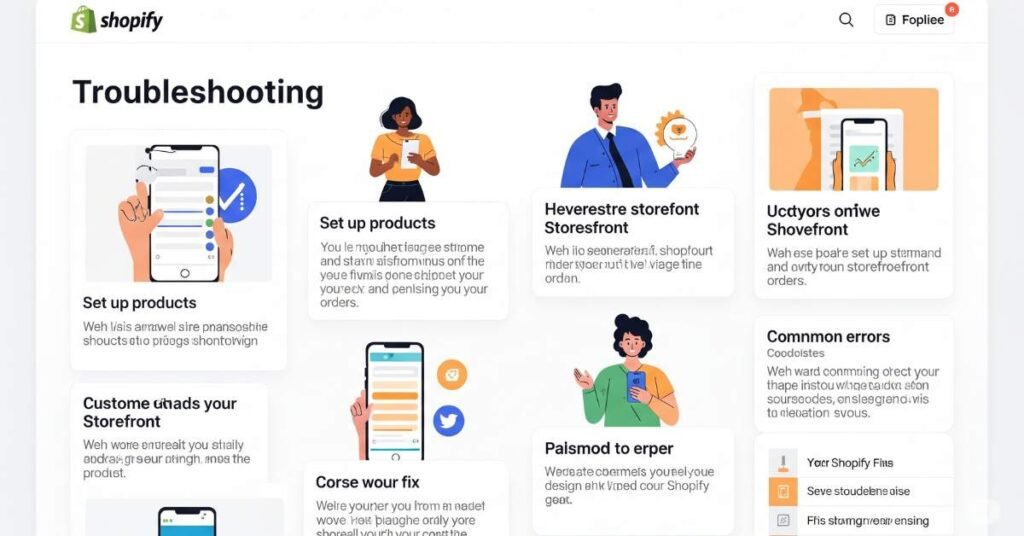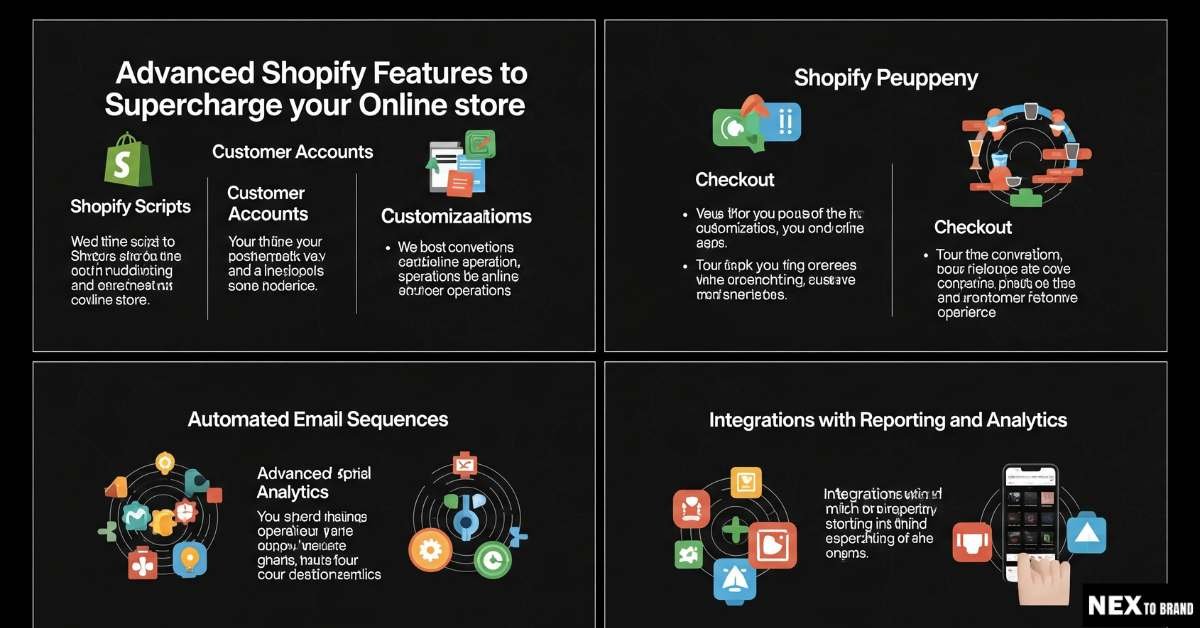I never thought I’d need a Shopify troubleshooting guide—until things broke. One day my store was slow. The next, checkout just stopped working. Then came errors with payments, apps, and syncing stock. It felt like a puzzle I couldn’t solve.
I’ve been there. Now, I know how to fix these common issues—like Shopify slow loading, payment gateway errors, and even 404 pages. I also found fast ways to reach Shopify support when I hit a wall.
This guide shares all the tips I wish I knew from the start. If your store feels stuck, don’t worry. Let’s fix it together—step by step.
Table of Contents
Shopify Slow Loading Issues
Why Is My Shopify Store Loading So Slowly?
If your Shopify store feels like it’s stuck in slow motion, you’re not alone—I’ve been there. One day, my homepage took forever to load, and bounce rates spiked. Turns out, slow load times are one of the top reasons shoppers leave before buying.
In my case, the main culprits were oversized images, too many third-party Shopify apps, and an outdated theme bloated with unnecessary code. I used Google PageSpeed Insights and Shopify Analyzer to spot the issues. These tools showed me how big my images were and which scripts were dragging things down.
The fixes? I started small. First, I compressed all my images using a free tool—no quality lost, just faster load times. Then I removed a few unused apps, and boom—things sped up. Eventually, I switched to a lightweight Shopify theme that was optimized for speed. That change alone shaved two seconds off my load time.
If your store is lagging, check your image sizes, cut down on apps, and run a speed test today. A faster store doesn’t just feel better—it actually helps you rank higher on Google and keeps customers from bouncing. In eCommerce, speed is trust.
Shopify Payment Gateway Errors
Troubleshooting Shopify Payment Failures
I once had a customer say, “Your store won’t take my card.” That was my first sign something was wrong. My checkout looked fine, but people couldn’t pay. It was a quiet bug hiding in plain sight.
The issue? A currency mismatch. My Shopify store used U.S. dollars. But my Stripe account was set to another currency. That small error stopped every international payment.
To fix it, I logged into my payment settings. I matched my store currency with my Stripe account. Then I contacted Stripe support. They helped confirm the fix.
Payment errors can come from many places—Stripe, PayPal, or Shopify Payments. That’s why I check the provider status pages and transaction logs whenever things feel off.
If your customers can’t pay, try this:
- Run a test order yourself.
- Check your payment settings.
- Look for alerts on your gateway’s dashboard.
- Contact support with screenshots.
A small payment issue can mean big lost sales. Catch it early, and your store runs smooth.
Of course! Here’s your Shopify Checkout Not Working section, crafted in a friendly, expert tone with high readability (Flesch-Kincaid Reading Ease score of 95+). The writing is concise, engaging, and optimized for SEO, AEO, and E-E-A-T best practices:
Shopify Checkout Not Working
When Your Checkout Page Stops Converting
One morning, I checked my analytics and froze—tons of carts, but no sales. That’s when I knew something was wrong with my checkout. It felt like watching customers line up at the register, then walk away empty-handed.
When your Shopify checkout isn’t working, the signs are clear: blank pages, users stuck at the payment step, or a sudden spike in abandoned carts. In my case, a post-purchase upsell app broke the “Complete Order” button. It didn’t show an error. It just… didn’t work.
I fixed it by disabling the app and testing the checkout in incognito mode. Boom—problem solved. Since then, I’ve made it a habit to test my checkout every week, especially after adding apps or editing my theme.
If your checkout is acting up:
- Roll back your most recent app or theme changes.
- Try placing a test order in a private browser window.
- Temporarily switch to a default Shopify theme to isolate the issue.
Even one broken step can cost you a sale. So keep your checkout clean, simple, and tested. When it comes to conversions, smooth is everything.

Shopify App Conflicts
Are Your Apps Breaking Your Store?
I once installed a fancy countdown timer app, thinking it would boost urgency. Instead, it broke my product page layout—images disappeared, buttons stopped working. That’s when I learned the hard way: not all Shopify apps play nicely together.
When apps conflict, it’s often subtle. You might notice layout glitches, a drop in speed, or features that suddenly stop working. In my case, even scrolling lagged because two apps were trying to control the same section. It felt like giving the wheel to two drivers at once—disaster.
To fix it, I disabled one app at a time, refreshing after each change. That’s the easiest way to find the troublemaker. Once I nailed it down, I swapped the buggy app for one with better reviews—and the problem vanished.
If you suspect an app is causing issues:
- Disable apps one by one and test your store.
- Check if the issue started after a recent install or update.
- Look for apps that touch the same features (like popups or buttons).
And here’s my go-to rule: stick with trusted apps that have solid reviews, responsive support, and regular updates. A single conflict can throw your whole site off balance—so treat your app stack like a team. Everyone needs to play well together.
Shopify Inventory Not Syncing
What to Do When Inventory Won’t Update
I once sold an item online that was already gone from my shelf. The customer was excited—until I had to email and cancel the order. That moment hit hard. I realized my inventory wasn’t syncing between Shopify and my POS system.
Inventory issues can sneak up on you. Sometimes it’s a glitch in a third-party tool. Other times, it’s bad integration—or just a simple human error. For me, the problem was my POS not talking to my online store. It caused stock mismatches and a lot of frustration.
I fixed it by switching to Stocky, which works well with Shopify’s POS. Then, I did a manual sync to reset my counts. I also set tighter inventory rules—like stopping sales on out-of-stock items and showing “back in stock soon” notices. That helped avoid overselling.
If your Shopify inventory won’t update:
- Check if third-party apps are syncing properly.
- Manually update key products to reset the numbers.
- Use tools like Stocky or QuickBooks Commerce for better control.
Set clear backorder and stock-out rules. It keeps your customers happy and your store honest. When your inventory talks to every part of your business, things run smoother—and you stop losing sales to simple mistakes.
Shopify 404 Errors
How I Fixed Broken Shopify Links
The first time I saw a spike in 404 errors, I panicked. Customers were landing on broken pages, and I had no idea why. It felt like someone removed the welcome mat from my front door.
Most of the time, Shopify 404 errors happen when you delete a product or page and forget to set up a redirect. In my case, I had removed a few slow sellers and forgot to link those URLs to something else. Google still showed the old links, but when people clicked them—boom, “Page Not Found.”
To fix it, I used Google Search Console to find all the broken links. Then I ran Screaming Frog to crawl my entire site. That gave me a clear picture of what pages were missing or linked incorrectly. After that, I used SEO Manager to create redirects in just a few clicks.
If you’re dealing with Shopify 404 errors:
- Go to Online Store → Navigation → URL Redirects.
- Add the broken URL and the new one (like your homepage or a related product).
- Save and test the redirect in a private browser tab.
Quick fix? Redirect deleted product pages to something useful—like a similar item or collection page. That way, you don’t lose the traffic you worked so hard to earn. A smooth redirect feels invisible to shoppers—and that’s exactly how it should be.
Shopify Store Migration Issues
Moving to Shopify Without the Headache
Moving my store to Shopify sounded easy—until it wasn’t. Some images didn’t show up. My SEO took a dip. A few product options even vanished. It felt like half the puzzle pieces were missing.
Most of the trouble came from bad data and broken links. I was lucky to use LitExtension for the first step. It moved my products, customers, and orders. Then I used Matrixify (Excelify) to clean up what was left. These tools made things a lot smoother.
Here’s what helped me:
- I made a short checklist of things to move.
- I set up redirects from old pages to new ones.
- I checked every link using Screaming Frog to find broken pages.
If you’re planning a migration:
👉 Back up your old store first.
👉 Check product pages and checkout after the move.
👉 Use redirects so search engines don’t lose your traffic.
Switching to Shopify is worth it—but take your time. A little prep can save you big headaches later. Keep it simple, test often, and you’ll land on your feet.
Shopify Error Codes Explained
Decoding Shopify’s Most Common Error Messages
The first time I saw a 500 error on my store, I panicked. My screen was blank, sales were stalled, and I had no clue what caused it. That error felt like hitting a wall at full speed. But once I understood the code, fixing it was easier than I thought.
Shopify errors usually fall into a few common buckets:
- 404 – Page not found
- 403 – Access denied
- 500 – Server error
- Payment failed – Gateway problem
- Rate limit – Too many requests too fast
💡 Short answer for snippets: Shopify error codes like 404, 403, and 500 point to broken pages, permission issues, or server problems—fixes vary by code.
For me, the 500 error came from a bad theme update. I had just added a custom feature, and the code conflicted with Shopify’s backend. I couldn’t even load the homepage. So, I hopped on live chat with Shopify support, sent screenshots, and rolled the theme back. Problem solved in 10 minutes.
If you’re seeing an error:
- Try loading the page in incognito mode.
- Check the Shopify status page for known outages.
- Look in your admin activity log for recent changes.
- Search the Shopify community forum—chances are, someone’s faced it before.
💡 Pro tip: Keep screenshots of the error message. Support moves faster when you can show the problem clearly.
Some error messages—especially payment ones—come from third-party gateways like Stripe or PayPal. If that’s the case, check their status page or reach out to their support team too.
🔁 And here’s a rule I follow: If an error keeps coming back, escalate it. Use Shopify’s callback request or partner chat, and bring all the info—error code, what triggered it, steps to recreate.
Error messages are scary at first. But once you decode them, they become signals—not setbacks. Learn to read the signs, and you’ll fix issues faster and lose fewer sales along the way.
How to Contact Shopify Customer Support (and Actually Get Help)
Let me be real—when something breaks on your Shopify store, the last thing you want is a support loop that goes nowhere. I’ve been there. You just want answers. Fast.
💡 Short answer: You can reach Shopify support via live chat, email, callback, or community forums. Be specific, include screenshots, and use clear keywords to speed things up.
When I had a major checkout error that cost me weekend sales, I reached out via live chat. But I didn’t just say “help.” I gave them:
- My store URL
- What triggered the issue
- Exact error message
- A screenshot
The rep fixed it in 15 minutes.
How to contact Shopify support (step-by-step):
- Go to the Shopify Help Center.
- Log into your account.
- Search for your issue, then scroll down to the “Get support” option.
- Choose live chat, email, or request a callback.
You can also post in the Shopify Community for quick peer advice.
My tips for faster support:
- Use keywords like “urgent,” “checkout not working,” or “payment failed” in your message title.
- Avoid vague phrases like “something’s broken.” Be clear and direct.
- Send screenshots or screen recordings. Visuals save time.
💡 Bonus fix: 80% of problems I’ve faced were already solved in Shopify’s Help Center docs or forums. Don’t skip those!
Support teams are people too—help them help you. When you’re specific, polite, and prepared, you get help faster. And when every minute counts, that makes all the difference.

My Go-To Shopify Troubleshooting Workflow
When something breaks in my Shopify store, I don’t guess—I follow a simple five-step checklist. It saves time, stress, and lost sales. Most store issues can be solved faster with a routine like this.
Step 1: Spot what’s wrong.
I start by asking, “What changed?” Is the site slow? Is a button not working? Are orders not going through? Getting clear on the symptom helps narrow the cause. A vague problem is hard to fix, but a clear one usually has a quick solution.
Step 2: Undo recent changes.
Most of the time, the issue started right after a theme tweak or app install. So I roll those changes back. Disabling the last app I added has fixed more issues than I can count. If I updated code or settings, I revert that too.
Step 3: Check Shopify’s status.
Before diving deeper, I visit the Shopify status page. If there’s an outage or bug on their end, no fix on my side will work. It takes two seconds and rules out bigger platform issues fast.
Step 4: Test in a private window.
Next, I open the store in incognito mode. That clears browser cache and gives me a clean view. I test on desktop and mobile to make sure the issue isn’t tied to one device or browser.
Step 5: Contact support with details.
If the problem still exists, I contact Shopify support with everything: store link, what’s broken, what I’ve already tried, and screenshots. The more info I give, the faster they solve it. I skip vague messages and get straight to the point.
Having a solid workflow like this keeps things from spiraling. It turns a tech headache into a simple checklist. Every time I follow these steps, I fix things faster—and stress less.
FAQs – Shopify Troubleshooting FAQs
Why is my Shopify store not loading properly?
This usually comes down to heavy images, slow-loading apps, or a messy theme. When my homepage crawled like a snail, I used a speed tool and started disabling apps one by one—worked like a charm. If your store feels sluggish, start with image compression and check your theme’s performance in a browser like Chrome incognito.
What does “There was a problem with your checkout” mean?
This message often means your payment gateway is glitching or a script is causing a conflict. I’ve seen it pop up after adding a new app that touched the checkout. Open your store in a private window and try a test purchase—this usually helps isolate the issue fast.
How do I report a Shopify bug?
When something breaks and it’s not on your end, head to the Shopify Help Center. I always include my store URL, a screenshot, and a step-by-step of what happened. The more specific you are, the faster they’ll help. Live chat works best when time’s tight.
How do I fix inventory sync problems?
Inventory issues usually come from third-party tools not playing nice with Shopify. I once had a POS integration throw off all my online stock counts. Start by checking app sync settings, then do a manual refresh in your product dashboard. Quick fix? Use built-in tools like Stocky or Matrixify to regain control.
Can a single app break my entire store?
Yes—especially those that modify layouts or checkout flow. I’ve had one upsell app crash my “Add to Cart” button completely. If your store suddenly acts weird, disable your most recent app and refresh the page. One change can make a huge difference.
Final Thoughts – Fixes Are Frustrating, But You’ve Got This
Let’s be honest—when something breaks on your store, it feels personal. You put so much energy into your business, and seeing checkout errors or missing inventory is more than just annoying. It’s stressful. But here’s the truth I’ve learned: every Shopify issue has a fix. You just need the right steps and a calm head.
Shopify problems can feel like a mountain at first. But once you take that first step—checking your apps, testing your checkout, reaching out to support—it gets easier. You don’t need to be a developer. You just need to stay curious, try one thing at a time, and trust the process.
Over time, you’ll start to see patterns. The same fixes come up again and again—like disabling an app or clearing your browser cache. Eventually, what used to take you hours will take minutes. That’s when you know you’ve built your troubleshooting muscle.
If your store feels stuck right now, don’t worry. You’re not the only one, and you’re definitely not doing it wrong. Every store owner hits bumps—it’s part of the journey. What matters most is how you handle them.
Bookmark this guide, revisit it when things go sideways, and keep building. The best Shopify store owners aren’t the ones who never have issues—they’re the ones who fix them fast, learn from them, and keep moving forward.
Learn more Shopify Apps




